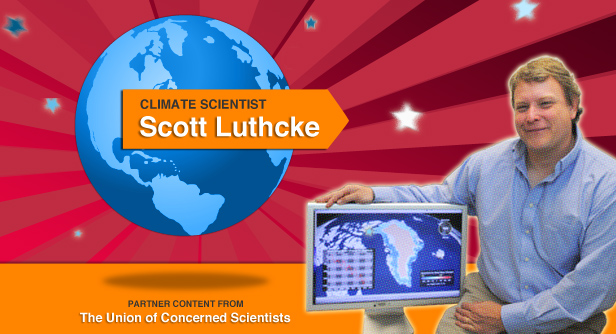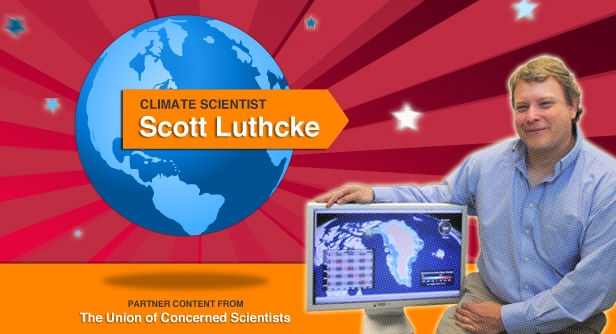
Scott Luthcke weighs Greenland — every 10 days. And the island has been losing weight, an average of 183 gigatons (or 200 cubic kilometers) — in ice — annually during the past six years. That’s one third the volume of water in Lake Erie every year. Greenland’s shrinking ice sheet offers some of the most powerful evidence of global warming.
Luthcke is a scientist at NASA’s Goddard Space Flight Center in Greenbelt, Maryland. He specializes in space geodesy, a branch of earth sciences that monitors Earth from space by measuring changes in the planet’s shape, orientation, and gravitational field.
Lutchke “weighs” Greenland by processing and interpreting data from one of the most sophisticated gravitational “scales” ever built: the U.S.-German satellite mission called GRACE — the Gravity Recovery and Climate Experiment.
GRACE consists of two satellites which orbit Earth in tandem at a relatively low altitude (450 to 500 kilometers). The pair operate in much the same way as a scale that uses a spring to gauge weight. “If you use a spring scale and attach a bucket full of tennis balls to it, the spring expands,” explains Luthcke. “When you take some of the balls out of the bucket, the spring correspondingly contracts and you can measure that variation.”
The two GRACE satellites can measure the distance between them with remarkable accuracy. Even though the satellites travel 220 kilometers (137 miles) apart from each other (roughly the distance from Philadelphia to Washington, D.C.), their sophisticated ranging systems, developed by NASA’s Jet Propulsion Laboratory, can detect variations in that distance down to a micron-or one-hundredth the width of a strand of human hair.
The GRACE ranging system functions as a giant scale by measuring variations in the gravitational pull of different land masses. Big land masses such as mountains exert a slightly stronger gravitational pull upon the satellites, causing minute fluctuations in their speed as they fly over.
For example, the two GRACE satellites fly over Greenland several times each day. As the first satellite approaches, the island’s mass causes the satellite to accelerate and thereby move slightly away from its trailing companion. Over time, the Grace mission carefully records fluctuations in the distance between the two satellites each time they pass over Greenland.
By examining the GRACE data, Luthcke can monitor subtle changes in the gravitational pull that the land mass exerts on the satellites to get a reliable measure of Greenland’s shrinking mass. The system, says Luthcke, is accurate enough to “detect the loss of just a centimeter of ice over an area the size of Delaware.”
Luthcke says he got hooked on space geodesy when, as a physics major in college, he landed a summer job at NASA. He never left, working his way “up from the mailroom” and contributing over the years to many NASA missions. “Space geodesy is a fantastic field,” Luthcke says. “I love my work because not only do I get to help develop and refine new space-borne sensors, but I get to be involved in using them to gather useful information. It is the best of both worlds.”
Because so many important decisions are likely to rest on his data, the key for Luthcke is accuracy. The challenge, he says, is being sure to “carefully analyze how well we know all the steps involved to turn the satellite’s raw observations into usable data.”
Luthcke strives to come up with a usable, regional calculation of the size of Greenland’s ice sheet. To do so, he uses sophisticated techniques to correct for “errors” that can creep into the data due to localized variations in mass or to other factors such as solar radiation pressure on the satellites themselves. “My goal is to do everything I can to minimize the uncertainties involved in these measurements,” he says. “It’s a good job for me because I’m a cautious person by nature who always wants to know how things will stand up under scrutiny.”
The good news for Luthcke is that a separate team using an entirely different method has come up with measurements of Greenland’s melting ice that, he says, are almost identical to his GRACE data. The bad news, of course, is that both sets of measurements make it all the more certain that Greenland’s ice is melting faster than anyone expected.
This is the second installment of America’s Climate Scientists: A series from the Union of Concerned Scientists. Click here to read all the climate scientist profiles.
The Union of Concerned Scientists is currently leading a campaign to elevate the voices of climate scientists and educate the public about the overwhelming scientific evidence for human-caused global warming. Learn how you can get involved at www.ucsusa.org/evidence.



